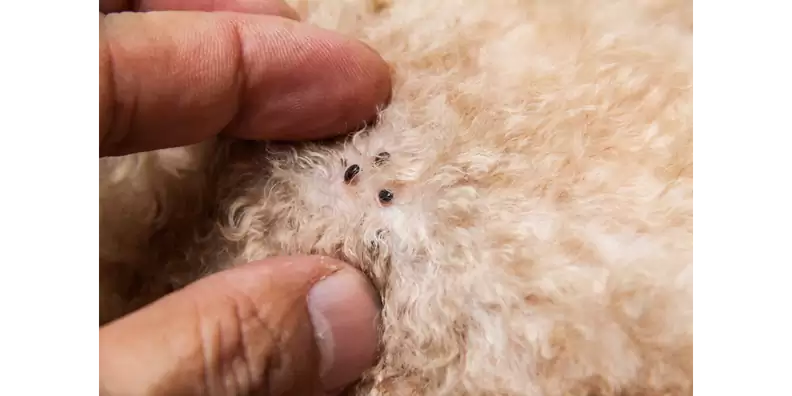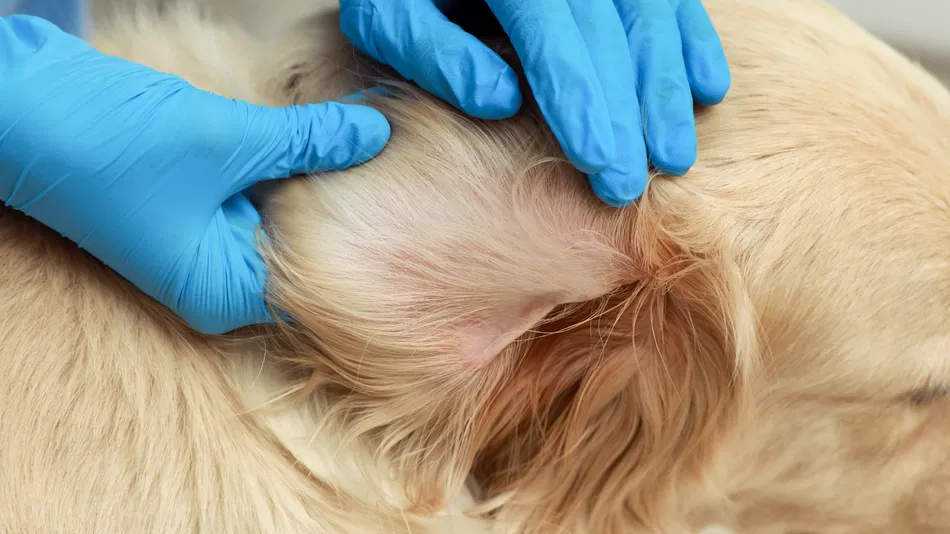Fleas have become the most bothersome pest problem for domestic dogs, so early detection saves dogs and their owners from unpleasant symptoms. Even though they measure only small sizes, fleas’ harm becomes substantial since they generate itching, skin irritation, and severe conditions that might lead to infections and anemia. Your dog’s increased scratching, together with its unusual restlessness, indicates pests have started attacking it. How to Tell If A Dog Has Fleas remains challenging despite what it may seem on the surface.
These little insects hide inside dog hair to create detectable indicators that people often overlook. The essential signs indicating your dog has fleas will be reviewed here, starting with your dog’s physical symptoms, followed by behavior changes and hidden signs throughout your home. Early detection of flea signs enables owners at any stage of pet experience to protect their dogs from infection and maintain their physical health and happiness.
Obvious Clues: Your Dog Might Be Struggling With Fleas
Non-Stop Scratching And Biting: Why Your Dog Can’t Stop Itching
The presence of fleas in dogs becomes evident in How To Tell If A Dog Has Fleas. When they continuously scratch and bite themselves. Flea bites result in itchy skin that compels dogs to gnaw at their affected areas. The scratching goes beyond ordinary itching because fleas maintain their biting patterns while your dog’s body fights off the fleas and their saliva.
Fleas In Plain Sight: How To Tell If A Dog Has Fleas And Flea Dirt
Due to their swift movements between your dog’s hair, the tiny dark brown fleas will prove challenging to How To Tell If A Dog Has Fleas. Flea infestations reveal themselves through the presence of little black specks that closely resemble pepper. Fur parting reveals small moving dots, which indicates the presence of fleas. Your dog has fallen victim to fleas when you find flea dirt on their coat since this waste material comes from completed flea feedings.
When Fleas Cause Hair Loss And Skin Irritation: Recognizing Hot Spots
Morphological and behavioral signs of continuous flea attacks extend beyond the itchiness by causing alopecia of the coat and creating bare spots while treating skin inflammation. Dogs’ repeated scratching and biting behavior can harm hair follicles, thus leading to hair loss. The areas around the tail, belly, and neck are the most common locations where fleas can be found, yet they end up causing persistent inflammation and irritation as time progresses. Persistent flea infections can lead to open sores and the medical condition known as hot spots.
You Might Also Like: How To Refresh Browser
Flea Eggs Everywhere: The Sneaky Signs Fleas Have Invaded Your Home
The egg-laying habits of fleas create a problem because the eggs drop from the dog and spread fully throughout your entire home. Small white oval flea eggs are evidence of How To Tell If A Dog Has Fleas and are visible only when you actively inspect because they blend in with their surroundings. Residing specks of eggs hide under your dog’s bedding and within carpet fibers in addition to sitting on upholstered furniture. After eggs hatch into larvae, adult fleas’ development process perpetuates the flea infestation cycle. Proper flea control creates success through consistently washing dog bedding and regular home vacuuming.
What Flea Bites Look Like On Your Dog’s Skin
Red, Irritated Skin: The Flea Bite’s Tell-Tale Signs
During a flea bite, your dog receives proteins through the flea’s saliva, preventing blood from clotting. Your dog develops skin allergic reactions from flea saliva, resulting in swelling in the wound area, skin irritation, and redness. You will most likely observe red, inflamed skin areas that are evidence of How To Tell If A Dog Has Fleas, where the fleas have eaten.
When you touch your dog, its skin will exhibit warmer-than-normal temperatures, revealing its inflamed condition. The discomfort of flea bites compels your dog to attack the affected spot with its paws, worsening the condition. The severity of redness can differ, but fleas tend to bite dogs on belly surfaces and near the neck and base of the tail because these body parts are favorable locations for their activity.

Sores And Scabs: How Flea Bites Can Lead To Open Wounds
Unattended flea bites will make your dog scratch and bite as the bites break their skin, developing into open sores with scabs forming at those sites. Your dog creates open wounds that indicate How To Tell If A Dog Has Fleas through its attempts to eliminate the discomfort of the bites. Skin damage through scratching becomes a pathway for bacteria to enter, resulting in severe pain, infection, and increased inflammation.
Your dog’s skin shows rough scabs throughout his body, especially on his neck, belly, and tail region. Maintaining clean skin while applying topical antibiotics creates two essential elements for stopping infection and reducing your dog’s pain symptoms.
Flea Allergic Dermatitis (FAD): What Happens When Fleas Cause Severe Reactions
The sensitivity of some dogs to flea saliva leads to How To Tell If A Dog Has Fleas. Your dog’s immune system produces intense allergic reactions to flea saliva proteins, which results in FAD. The skin areas affected by fleas cause dogs with FAD to suffer from intense itching, which leads to redness and swelling and eventually results in hair loss on affected parts. The continuous itching reaches levels, which drive dogs to create secondary skin problems due to persistent scratching.
Your dog can develop FAD symptoms on its lower back, tail regions, and neck, yet any body part remains possible. To diagnose FAD in your dog, you should see a veterinarian. They will prescribe the most suitable treatment to control the allergic response, recommending flea prevention solutions, antihistamines, and possible corticosteroid options.
Behavioral Shifts That Could Signal Fleas Are the Culprit
Focused Licking And Biting: Why Dogs Zero In On Certain Areas
How To Tell If A Dog Has Fleas, your dog will target licking and biting activities against the body sections where the pests are actively present. The areas that attract fleas for biting most frequently correspond to the tail base, stomach, and region near the neck and armpits. Flea bites create such intense itchiness that your dog tries to cope by licking and biting those areas. You can observe your dog licking and biting one area until their skin becomes red and swollen.
When Fleas Affect Your Dog’s Mood: A Drop In Appetite And Playfulness
The physical effects of fleas on dogs extend beyond body-related problems, including negative impacts on their mood and general health. How To Tell If A Dog Has Fleas leads to discomfort, which makes your dog experience stress and irritability, causing their behavior to change. A significant indication that your dog has fleas is when their food appetite decreases noticeably. Your dog’s mood changes from exuberant to withdrawn with reduced responsiveness points to fleas being an active infestation cause. Treating the flea infestation will bring back their energy and improve their general behavior.
Frequently Asked Questions
What Indicators Tell Me That Fleas Exist on My Dog?
Your dog may display behavior traits such as excessive scratching and purposeful fur licking on specific body locations, showing signs of feces.
Can Fleas Inhabit My Dog’s Body Without Me Detecting Their Presence?
Fleas can survive beneath your dog’s fur, although they remain invisible to the eye, which can cause irritation to the dog’s fur.
What Steps Should I Take If I Locate Fleas On My Dog?
You should give your dog flea medication through oral treatments, spot-on solutions, or pharmaceutical collars to treat the problem.
Conclusion
The health impacts of fleas are substantial for your dog, even though they remain tiny. How To Tell If A Dog Has Fleas Infestations at an Early Stage becomes possible when you observe signs, which include persistent scratching and flea visibility, as well as moves such as restlessness in your dog. The protection of your dog’s health depends on scheduled inspections combined with quick treatment procedures alongside regular home upkeep, which effectively fights off fleas.




[…] You Might Also Like: How To Tell If A Dog Has Fleas […]